Metamaterial-Inspired Electrically Compact Triangular Antennas Loaded with CSRR and 3 × 3 Cross-Slots for 5G Indoor Distributed Antenna Systems
Abstract
:1. Introduction
2. Proposed Antenna Design
2.1. CSRR MTM Structure Inserted to Proposed Antenna
2.2. Metallic-Cross Metamaterial Structure
2.3. Cross-Slot Metamaterial Structure Etched in the Ground Plane of Proposed Antenna
3. Analysis of Proposed Design with Different Substrate
4. Result and Discussion
5. Comparison
6. Conclusions
Author Contributions
Funding
Acknowledgments
Conflicts of Interest
References
- Shafique, K.; Khawaja, B.A.; Sabir, F.; Qazi, S.; Mustaqim, M. Internet of Things (IoT) for Next-Generation Smart Systems: A Review of Current Challenges, Future Trends and Prospects for Emerging 5G-IoT Scenarios. IEEE Access 2020, 8, 23022–23040. [Google Scholar] [CrossRef]
- Rappaport, T.S.; Xing, Y.; Kanhere, O.; Ju, S.; Madanayake, A.; Mandal, S.; Alkhateeb, A.; Trichopoulos, G.C. Wireless Communications and Applications Above 100 GHz: Opportunities and Challenges for 6G and Beyond. IEEE Access 2019, 7, 78729–78757. [Google Scholar] [CrossRef]
- Zhou, L.; Jiao, Y.; Qi, Y.; Weng, Z.; Lu, L. Wideband Ceiling-Mount Omnidirectional Antenna for Indoor Distributed Antenna Systems. IEEE Antennas Wirel. Propag. Lett. 2014, 13, 836–839. [Google Scholar] [CrossRef]
- Singhal, S.; Singh, A.K. Modified star-star fractal (MSSF) super-wideband antenna. Microw. Opt. Technol. Lett. 2017, 59, 624–630. [Google Scholar] [CrossRef]
- Waladi, V.; Mohammadi, N.; Zehforoosh, Y.; Habashi, A.; Nourinia, J. A Novel Modified Star-Triangular Fractal (MSTF) Monopole Antenna for Super-Wideband Applications. IEEE Antennas Wirel. Propag. Lett. 2013, 12, 651–654. [Google Scholar] [CrossRef]
- Manohar, M. Miniaturised low-profile super-wideband Koch snowflake fractal monopole slot antenna with improved BW and stabilised radiation pattern. IET Microw. Antennas Propag. 2019, 13, 1948–1954. [Google Scholar] [CrossRef]
- Hussein, M.I.; Hakam, A.; Ouda, M. Planar Ultra-Wideband Elliptical Antenna for Communication Applications. In Proceedings of the 2016 IEEE Wireless Communications and Networking Conference, Doha, Qatar, 3–6 April 2016; pp. 1–5. [Google Scholar]
- Liang, X.-L.; Zhong, S.-S.; Wang, W. Elliptical planar monopole antenna with extremely wide bandwidth. Electron. Lett. 2006, 42, 441–442. [Google Scholar] [CrossRef]
- Yan, X.-R.; Zhong, S.-S.; Liang, X.-L. Compact printed semi-elliptical monopole antenna for super-wideband applications. Microw. Opt. Technol. Lett. 2007, 49, 2061–2063. [Google Scholar] [CrossRef]
- Manohar, M.; Nemani, U.K.; Kshetrimayum, R.S.; Gogoi, A.K. A Novel Super Wideband Notched Printed Trapezoidal Monopole Antenna with Triangular Tapered Feedline. In Proceedings of the 2014 International Conference on Signal Processing and Communications (SPCOM), Bangalore, India, 22–25 July 2014; pp. 1–6. [Google Scholar]
- Manohar, M.; Kshetrimayum, R.S.; Gogoi, A.K. A Compact Dual Band-Notched Circular Ring Printed Monopole Antenna for Super wideband Applications. Radioengineering 2017, 26, 64–70. [Google Scholar] [CrossRef]
- Dong, Y.; Hong, W.; Liu, L.; Zhang, Y.; Kuai, Z. Performance analysis of a printed super-wideband antenna. Microw. Opt. Technol. Lett. 2009, 51, 949–956. [Google Scholar] [CrossRef]
- Wang, Z.; Dong, Y.; Itoh, T. Transmission Line Metamaterial-Inspired Circularly Polarized RFID Antenna. IEEE Antennas Wirel. Propag. Lett. 2020, 19, 964–968. [Google Scholar] [CrossRef]
- Vallappil, A.K.; Rahim, M.K.A.; Khawaja, B.A.; Iqbal, M.N. Compact Metamaterial Based $4\times4$ Butler Matrix with Improved Bandwidth for 5G Applications. IEEE Access 2020, 8, 13573–13583. [Google Scholar] [CrossRef]
- Cao, W.; Ma, W.; Peng, W.; Chen, Z.N. Bandwidth-Enhanced Electrically Large Microstrip Antenna Loaded With SRR Structures. IEEE Antennas Wirel. Propag. Lett. 2019, 18, 576–580. [Google Scholar] [CrossRef]
- Xu, L.; Zhou, Y.J. Low Profile High-Gain Antenna for Broadband Indoor Distributed Antenna System. Appl. Comput. Electromagn. Soc. J. (ACES) 2020, 35, 791–796. [Google Scholar]
- Xu, H.-X.; Wang, G.-M.; Liang, J.-G.; Qi, M.Q.; Gao, X. Compact Circularly Polarized Antennas Combining Meta-Surfaces and Strong Space-Filling Meta-Resonators. IEEE Trans. Antennas Propag. 2013, 61, 3442–3450. [Google Scholar] [CrossRef]
- Chang, K.; Jiang, T.; Ran, L.; Xin, H. Investigation of Microwave Negative Refractive Index (NRI) Transmission Lines Incorporating Tunnel Diodes. IEEE Antennas Wirel. Propag. Lett. 2012, 11, 671–674. [Google Scholar] [CrossRef]
- Jin, C.; Alphones, A.; Tsutsumi, M. Double Periodic Composite Right/Left Handed Transmission Line and Its Applications to Compact Leaky-Wave Antennas. IEEE Trans. Antennas Propag. 2011, 59, 3679–3686. [Google Scholar] [CrossRef]
- He, S. Electromagnetic Metamaterials: Transmission Line Theory and Microwave Applications. By Christophe Caloz and Tatsuo Itoh. ChemPhysChem 2007, 8, 618–619. [Google Scholar] [CrossRef]
- Hu, X. Some Studies on Metamaterial Transmission Lines and Their Applications. 2009. Available online: http://kth.diva-portal.org/smash/get/diva2:209235/FULLTEXT01.pdf (accessed on 29 December 2021).
- Ghaneizadeh, A.; Mafinezhad, K.; Joodaki, M. An extremely ultrathin flexible Huygens’s transformer. AIP Adv. 2020, 10, 105201. [Google Scholar] [CrossRef]
- Pendry, J.B.; Holden, A.J.; Stewart, W.J.; Youngs, I. Extremely Low Frequency Plasmons in Metallic Mesostructures. Phys. Rev. Lett. 1996, 76, 4773–4776. [Google Scholar] [CrossRef] [Green Version]
- Pendry, J.B.; Holden, A.J.; Robbins, D.J.; Stewart, W.J. Low frequency plasmons in thin-wire structures. J. Physics: Condens. Matter 1998, 10, 4785–4809. [Google Scholar] [CrossRef]
- Smith, D.R.; Padilla, W.J.; Vier, D.C.; Nemat-Nasser, S.C.; Schultz, S. Composite Medium with Simultaneously Negative Permeability and Permittivity. Phys. Rev. Lett. 2000, 84, 4184–4187. [Google Scholar] [CrossRef] [PubMed] [Green Version]
- Chen, H.; Ran, L.; Huangfu, J.; Zhang, X.; Chen, K.; Grzegorczyk, T.M.; Kong, J.A. Metamaterial exhibiting left-handed properties over multiple frequency bands. J. Appl. Phys. 2004, 96, 5338–5340. [Google Scholar] [CrossRef]
- Islam, S.S.; Faruque, M.R.I.; Islam, M.T. The Design and Analysis of a Novel Split-H-Shaped Metamaterial for Multi-Band Microwave Applications. Materials 2014, 7, 4994–5011. [Google Scholar] [CrossRef] [PubMed] [Green Version]
- Zhou, H.; Wang, C.; Peng, H. A novel double-incidence and multi-band left-handed metamaterials composed of double Z-shaped structure. J. Mater. Sci. Mater. Electron. 2015, 27, 2534–2544. [Google Scholar] [CrossRef]
- Xu, H.-X.; Wang, G.-M.; Zhang, C.-X.; Liu, Q.; Xu, Z.-M.; Chen, X.; Zhai, D.-L. Multi-band left-handed metamaterial inspired by tree-shaped fractal geometry. Photon-Nanostructures-Fundam. Appl. 2013, 11, 15–28. [Google Scholar] [CrossRef]
- Wang, J.; Qu, S.; Yang, Y.; Ma, H.; Wu, X.; Xu, Z. Multiband left-handed metamaterials. Appl. Phys. Lett. 2009, 95, 14105. [Google Scholar] [CrossRef]
- Jia, X.; Wang, X.; Meng, Q.; Zhou, Z. Tunable multi-band chiral metamaterials based on double-layered asymmetric split ring resonators. Phys. E Low-Dimens. Syst. Nanostructures 2016, 81, 37–43. [Google Scholar] [CrossRef] [Green Version]
- Wang, W.; Xu, C.; Yan, M.; Wang, A.; Wang, J.; Feng, M.; Wang, J.; Qu, S. Broadband Tunable Metamaterial Absorber Based on U-shaped Ferrite Structure. IEEE Access 2019, 7, 150969–150975. [Google Scholar] [CrossRef]
- Deng, G.; Hu, L.; Mo, H.; Xu, J.; Yin, Z.; Lu, H.; Hu, M.; Li, J.; Yang, J. A tunable terahertz metamaterial wideband absorber with liquid crystal. Opt. Mater. Express 2021, 11, 4026–4035. [Google Scholar] [CrossRef]
- Bang, S.; Kim, J.; Yoon, G.; Tanaka, T.; Rho, J. Recent Advances in Tunable and Reconfigurable Metamaterials. Micromachines 2018, 9, 560. [Google Scholar] [CrossRef] [PubMed] [Green Version]
- Pitchappa, P.; Ho, C.P.; Lin, Y.-S.; Kropelnicki, P.; Huang, C.-Y.; Singh, N.; Lee, C. Micro-electro-mechanically tunable metamaterial with enhanced electro-optic performance. Appl. Phys. Lett. 2014, 104, 151104. [Google Scholar] [CrossRef]
- Vallappil, A.K.; Rahim, M.K.A.; Khawaja, B.A.; Iqbal, M.N.; Murad, N.A.; Gajibo, M.M.; Nur, L.O.; Nugroho, B.S. Complementary split-ring resonator and strip-gap based metamaterial fractal antenna with miniature size and enhanced bandwidth for 5G applications. J. Electromagn. Waves Appl. 2021, 1–17. [Google Scholar] [CrossRef]
- Amiri, M.; Tofigh, F.; Shariati, N.; Lipman, J.; Abolhasan, M. Wide-angle metamaterial absorber with highly insensitive absorption for TE and TM modes. Sci. Rep. 2020, 10, 13638. [Google Scholar] [CrossRef]
- Ghaneizadeh, A.; Joodaki, M.; Borcsok, J.; Golmakani, A.; Mafinezhad, K. Analysis, Design, and Implementation of a New Extremely Ultrathin 2-D-Isotropic Flexible Energy Harvester Using Symmetric Patch FSS. IEEE Trans. Microw. Theory Tech. 2020, 68, 2108–2115. [Google Scholar] [CrossRef]
- Engelberg, J.; Levy, U. The advantages of metalenses over diffractive lenses. Nat. Commun. 2020, 11, 1991. [Google Scholar] [CrossRef]
- Moreno, G.; Yakovlev, A.B.; Bernety, H.M.; Werner, D.H.; Xin, H.; Monti, A.; Bilotti, F.; Alu, A. Wideband Elliptical Metasurface Cloaks in Printed Antenna Technology. IEEE Trans. Antennas Propag. 2018, 66, 3512–3525. [Google Scholar] [CrossRef]
- Siddiqui, M.G.; Saroj, A.K.; Devesh; Ansari, J.A. Multi-band fractaled triangular microstrip antenna for wireless applications. Prog. Electromagn. Res. M 2018, 65, 51–60. [Google Scholar] [CrossRef] [Green Version]
- Pozar, D.M. Microwave Engineering, 3rd ed.; John Wiley and Sons: Hoboken, NJ, USA, 2005. [Google Scholar]
- Study on Implications of 5G Deployment on Future Business Models. Available online: https://berec.europa.eu/eng/document_register/subject_matter/berec/reports/8008-study-on-implications-of-5g-deployment-on-future-business-models (accessed on 8 October 2018).
- Press Release: Final Report on Allocation of Spectrum Bands for Mobile Broadband Service in Malaysia | Malaysian Communications and Multimedia Commission (MCMC). Available online: https://www.mcmc.gov.my/en/media/press-releases/final-report-on-allocation-of-spectrum-bands-for-m (accessed on 25 March 2020).
- Vallappil, A.K.; Rahim, M.K.A.; Khawaja, B.A.; Murad, N.A. Metamaterial Minkowski Fractal Antenna with Defective Ground Structure. In Proceedings of the 2021 International Symposium on Antennas and Propagation (ISAP), Taipei, Taiwan, 19–22 October 2021; pp. 1–2. [Google Scholar]
- Saravanan, M.; Umarani, S.M. Gain enhancement of patch antenna integrated with metamaterial inspired superstrate. J. Electr. Syst. Inf. Technol. 2018, 5, 263–270. [Google Scholar] [CrossRef]
- Al-Bawri, S.S.; Islam, S.; Wong, H.Y.; Jamlos, M.F.; Narbudowicz, A.; Jusoh, M.; Sabapathy, T.; Islam, M.T. Metamaterial Cell-Based Superstrate towards Bandwidth and Gain Enhancement of Quad-Band CPW-Fed Antenna for Wireless Applications. Sensors 2020, 20, 457. [Google Scholar] [CrossRef] [Green Version]
- Costa, F.; Borgese, M.; Degiorgi, M.; Monorchio, A. Electromagnetic Characterisation of Materials by Using Transmission/Reflection (T/R) Devices. Electronics 2017, 6, 95. [Google Scholar] [CrossRef] [Green Version]
- Lopato, P.; Herbko, M. Evaluation of Selected Metasurfaces’ Sensitivity to Planar Geometry Distortions. Appl. Sci. 2019, 10, 261. [Google Scholar] [CrossRef] [Green Version]
- Alibakhshikenari, M.; Virdee, B.S.; Althuwayb, A.A.; Azpilicueta, L.; Parchin, N.O.; See, C.H.; Abd-Alhameed, R.A.; Falcone, F.; Huynen, I.; Denidni, T.A.; et al. Bandwidth and gain enhancement of composite right left handed metamaterial transmission line planar antenna employing a non foster impedance matching circuit board. Sci. Rep. 2021, 11, 7472. [Google Scholar] [CrossRef] [PubMed]
- Salman, J.W.; Ameen, M.M.; Hassan, S.O. Effects of the Loss Tangent, Dielectric Substrate Permittivity and Thickness on the Performance of Circular Microstrip Antennas. J. Eng. Sustain. Dev. (JEASD) 2006, 10, 1–13. [Google Scholar]
- Saraswat, R.K.; Kumar, M. A metamaterial loaded hybrid fractal multiband antenna for wireless applications with frequency band reconfigurability characteristics. Frequenz 2020, 74, 401–416. [Google Scholar] [CrossRef]
- Abdalla, M.A.; Hu, Z.; Muvianto, C. Analysis and design of a triple band metamaterial simplified CRLH cells loaded monopole antenna. Int. J. Microw. Wirel. Technol. 2016, 9, 903–913. [Google Scholar] [CrossRef]
- Dai, G.; Xu, X.; Deng, X.; Zhang, Z.; Liu, J.; Su, J.; Song, J.; Gao, Y.; Peng, W.; Wang, M.; et al. Size-Reduced Equilateral Triangular Metamaterial Patch Antenna Designed for Mobile Communications. Appl. Comput. Electromagn. Soc. J. 2021, 36, 1026–1030. [Google Scholar] [CrossRef]
- Zhang, B.; Pi, K.; Xu, X. Compact and Wideband Circularly Polarized Metamaterial Antenna for the 35GHz Band Communication. In Proceedings of the 2021 Cross Strait Radio Science and Wireless Technology Conference (CSRSWTC), Shenzhen, China, 11–13 October 2021; pp. 287–288. [Google Scholar]
- Zhu, J.-X.; Bai, P.; Wang, J.-F. Ultrasmall Dual-Band Metamaterial Antennas Based on Asymmetrical Hybrid Resonators. Available online: https://www.hindawi.com/journals/ijap/2016/7019268/ (accessed on 6 October 2020).
- Rosaline, S.I. A triple-band antenna with a metamaterial slab for gain enhancement and specific absorption rate (sar) reduction. Prog. Electromagn. Res. C 2021, 109, 275–287. [Google Scholar] [CrossRef]
- Hasan, M.; Rahman, M.; Faruque, M.R.I.; Islam, M.T.; Khandaker, M.U. Electrically Compact SRR-Loaded Metamaterial Inspired Quad Band Antenna for Bluetooth/WiFi/WLAN/WiMAX System. Electronics 2019, 8, 790. [Google Scholar] [CrossRef] [Green Version]

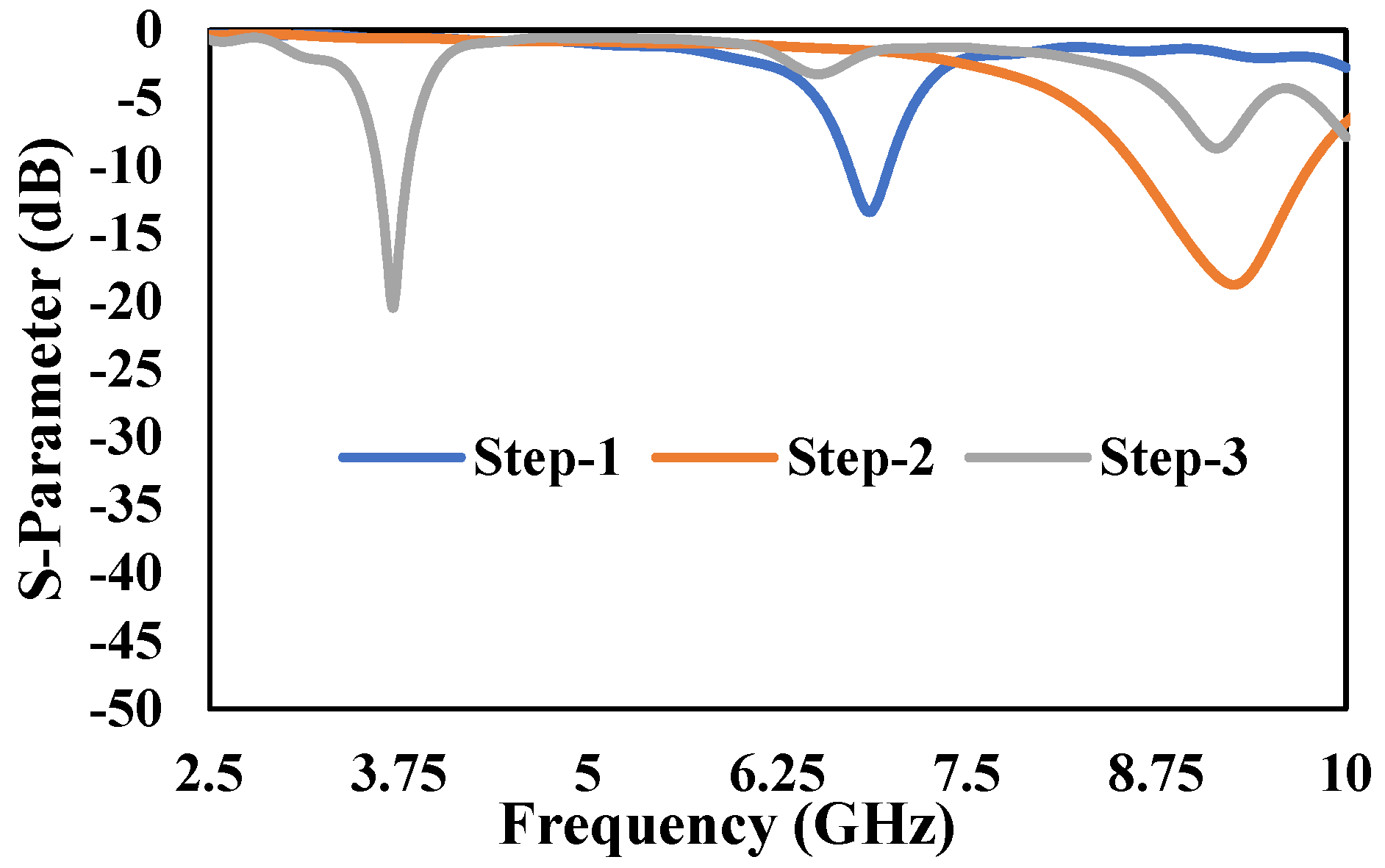

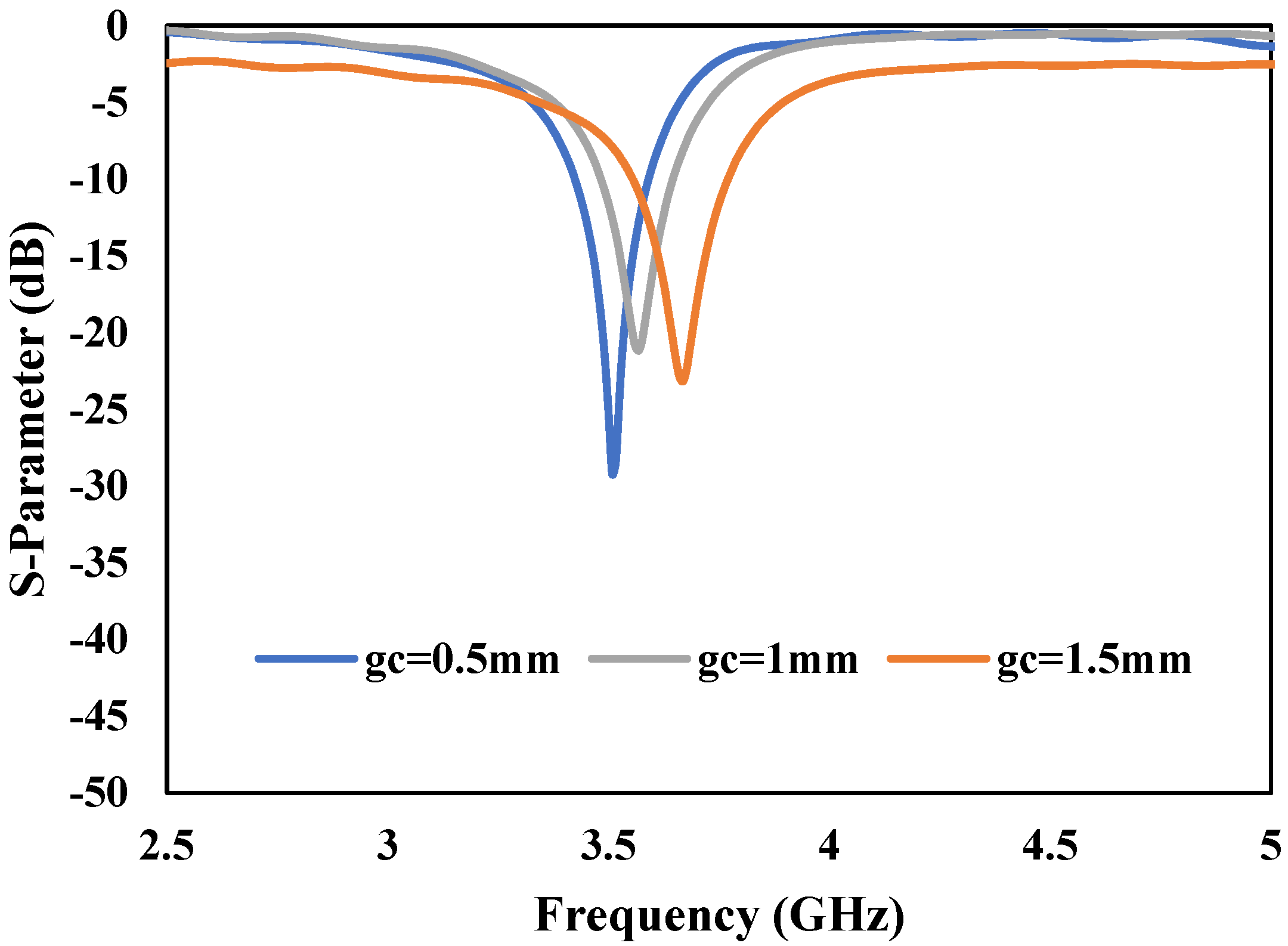
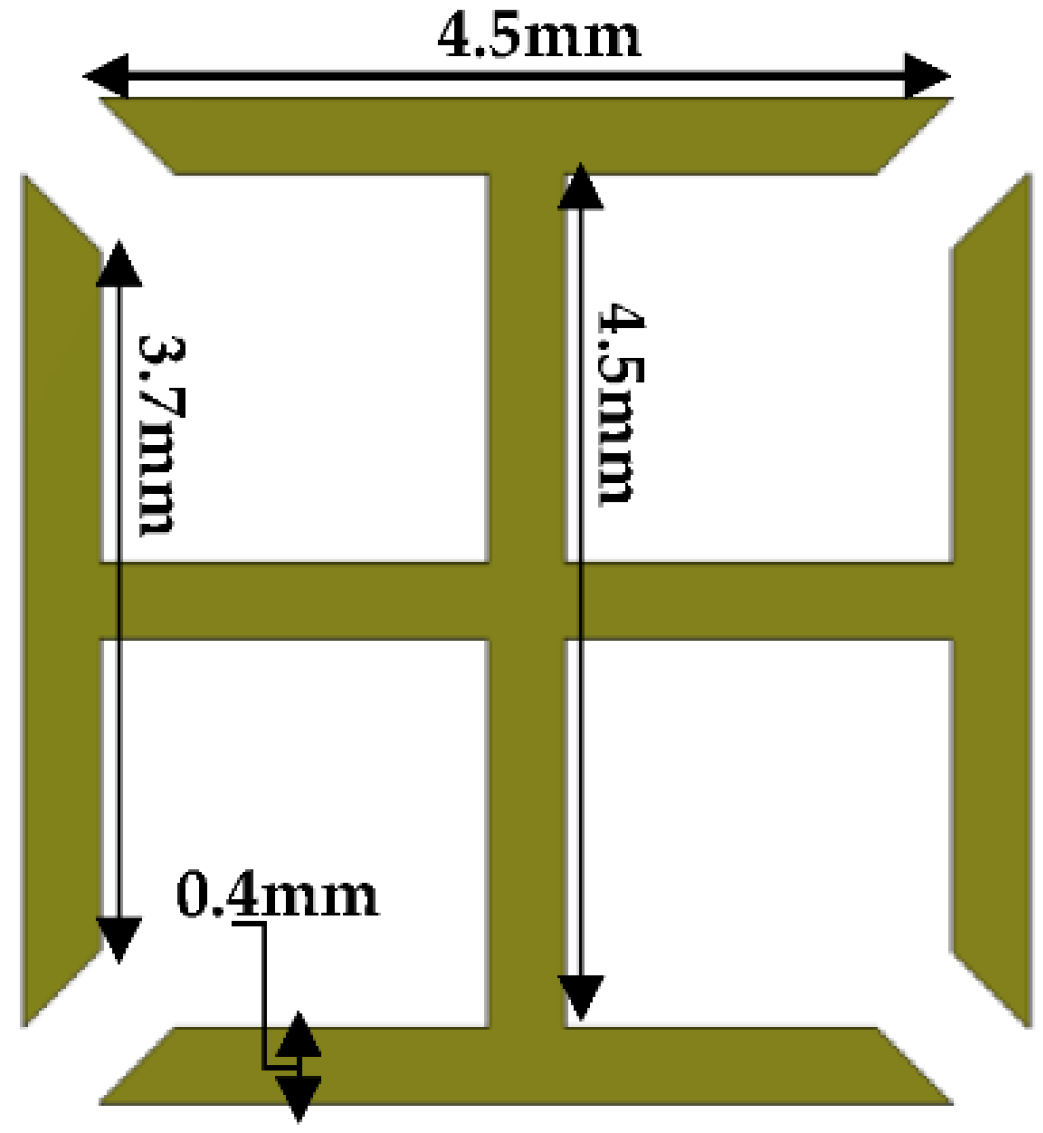
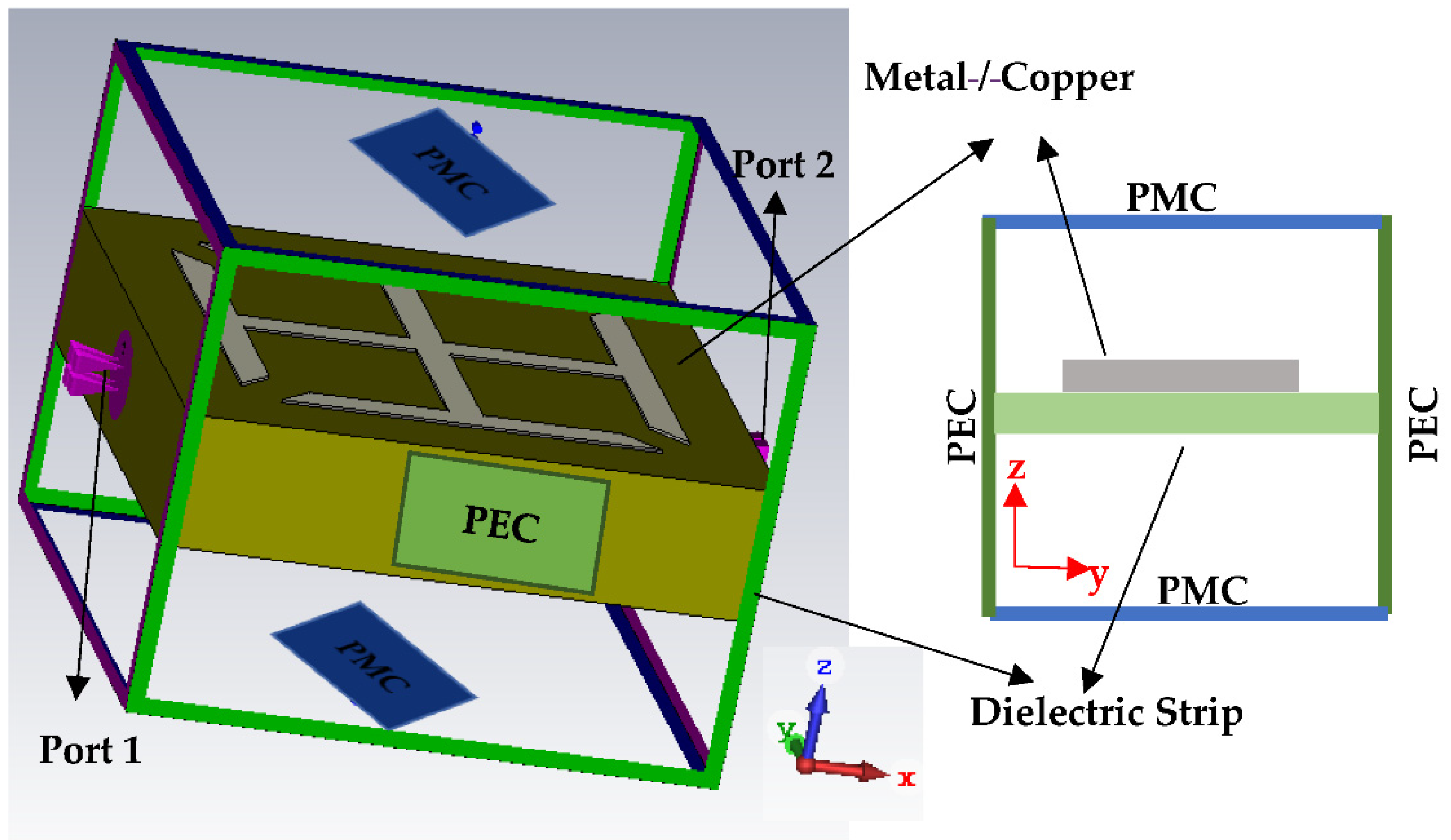
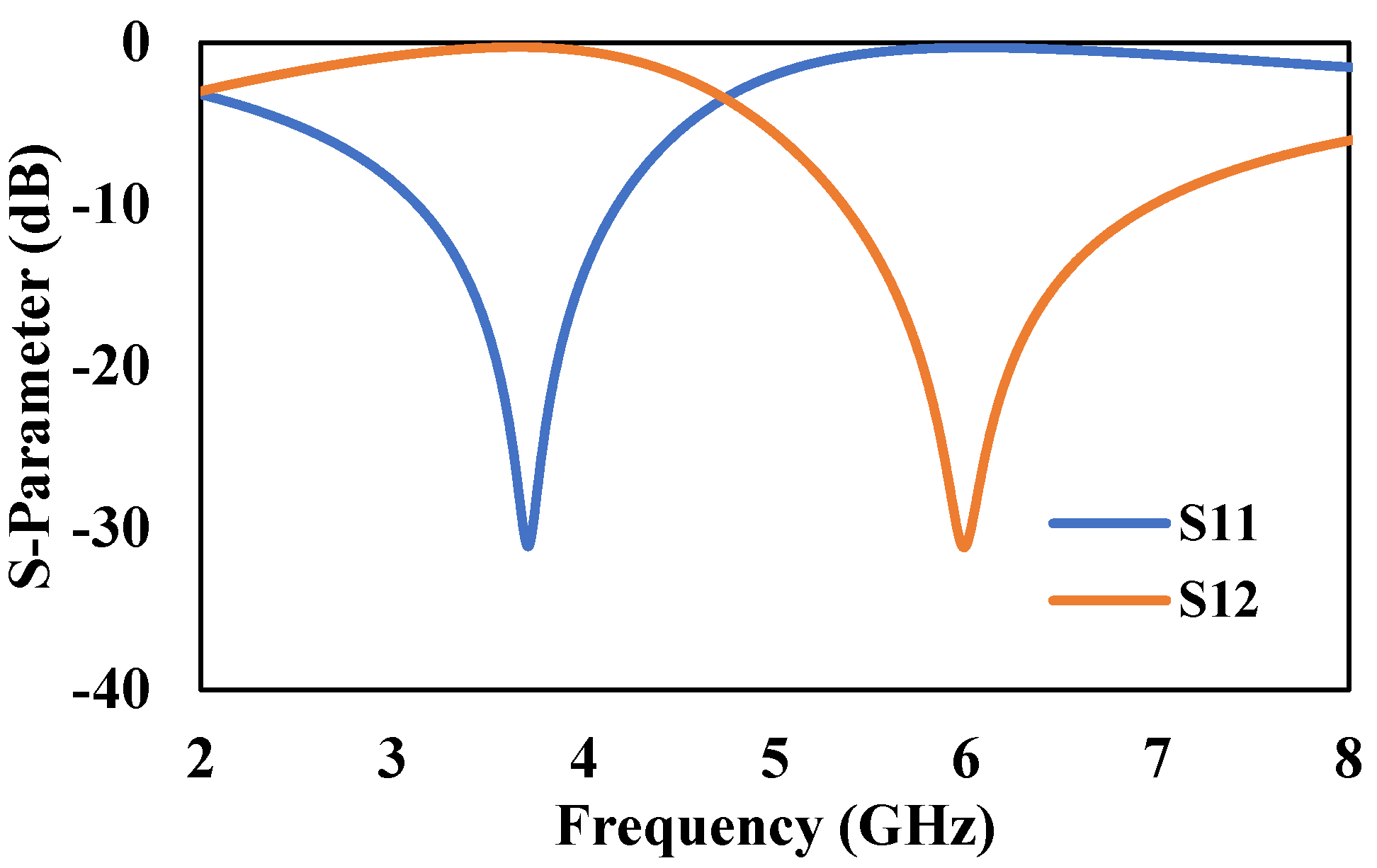

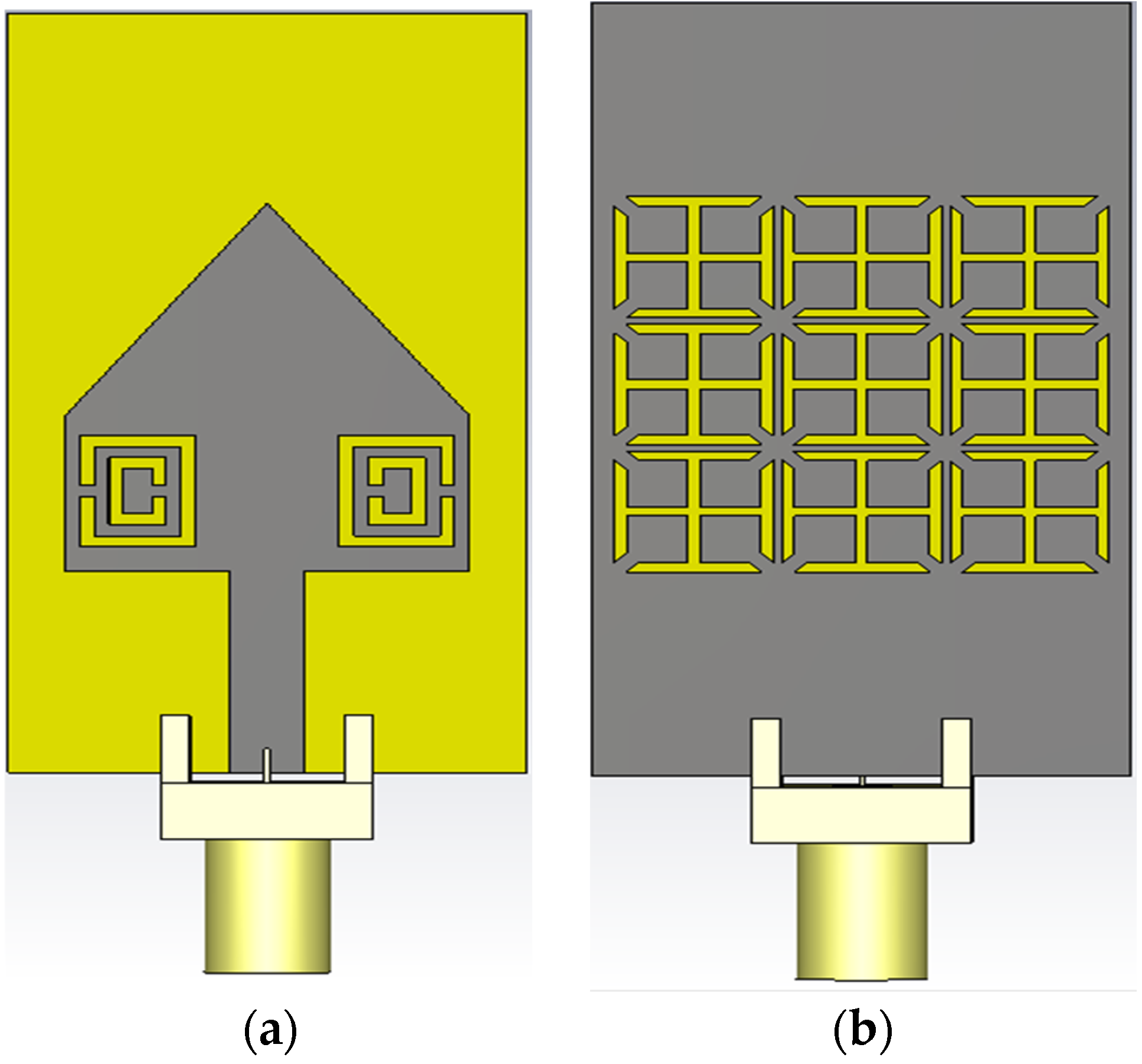

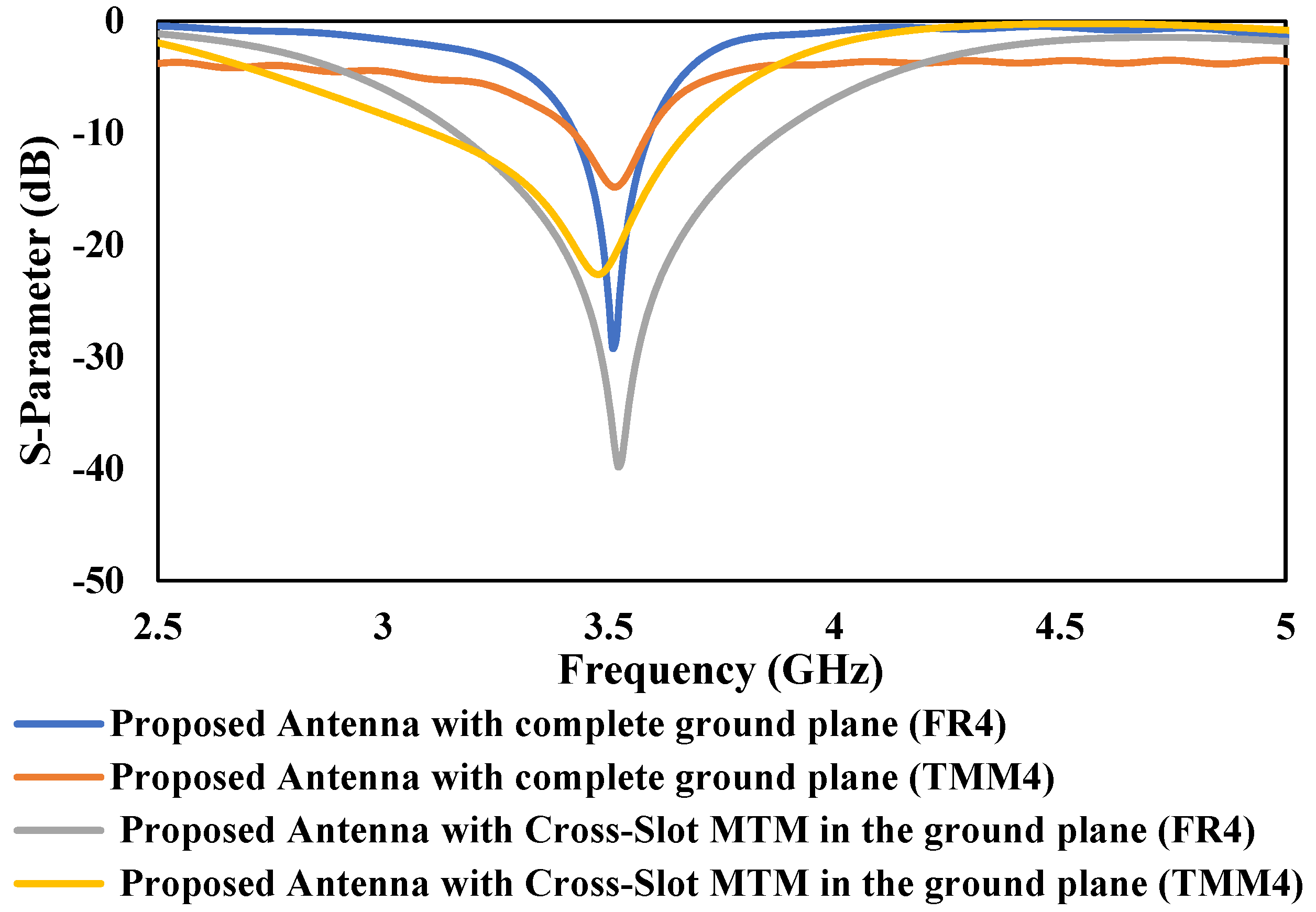


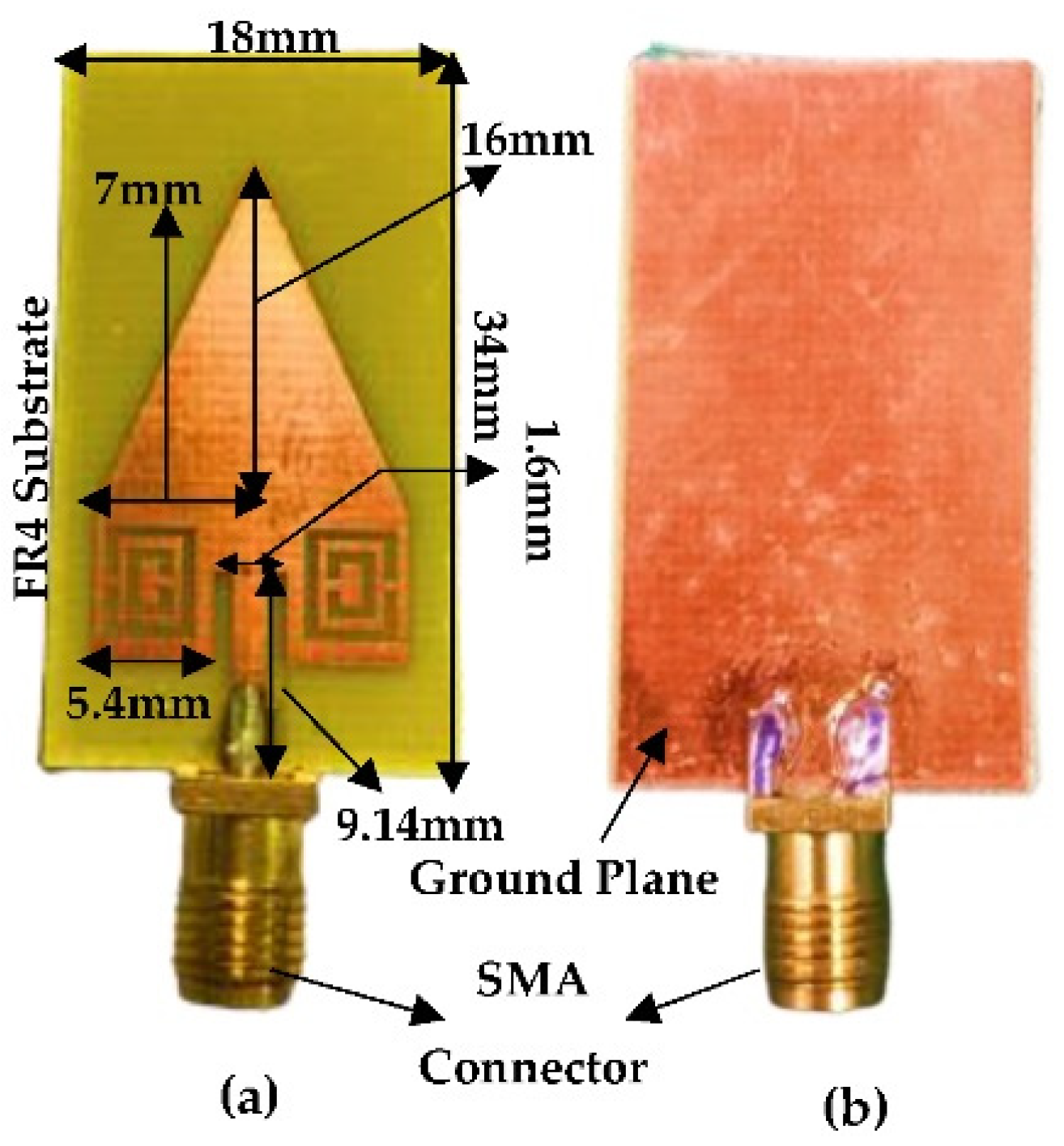
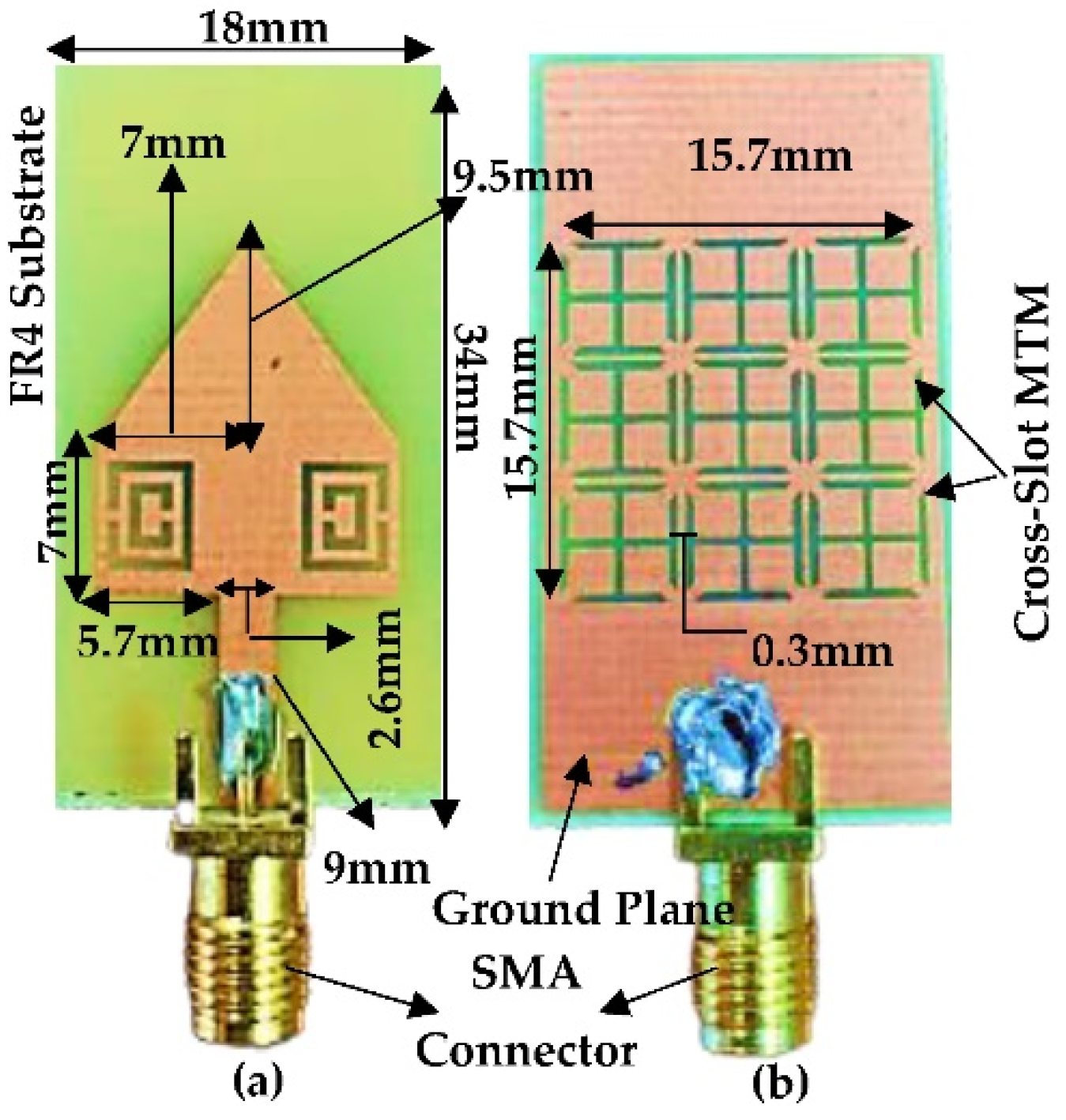
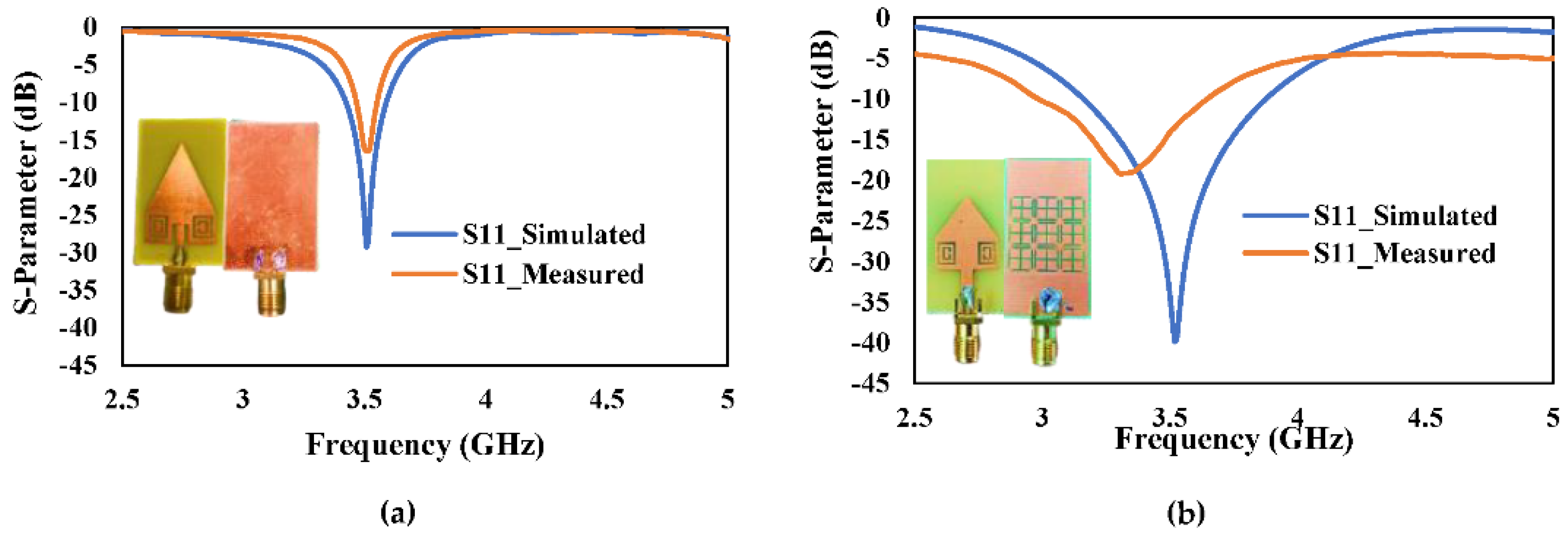
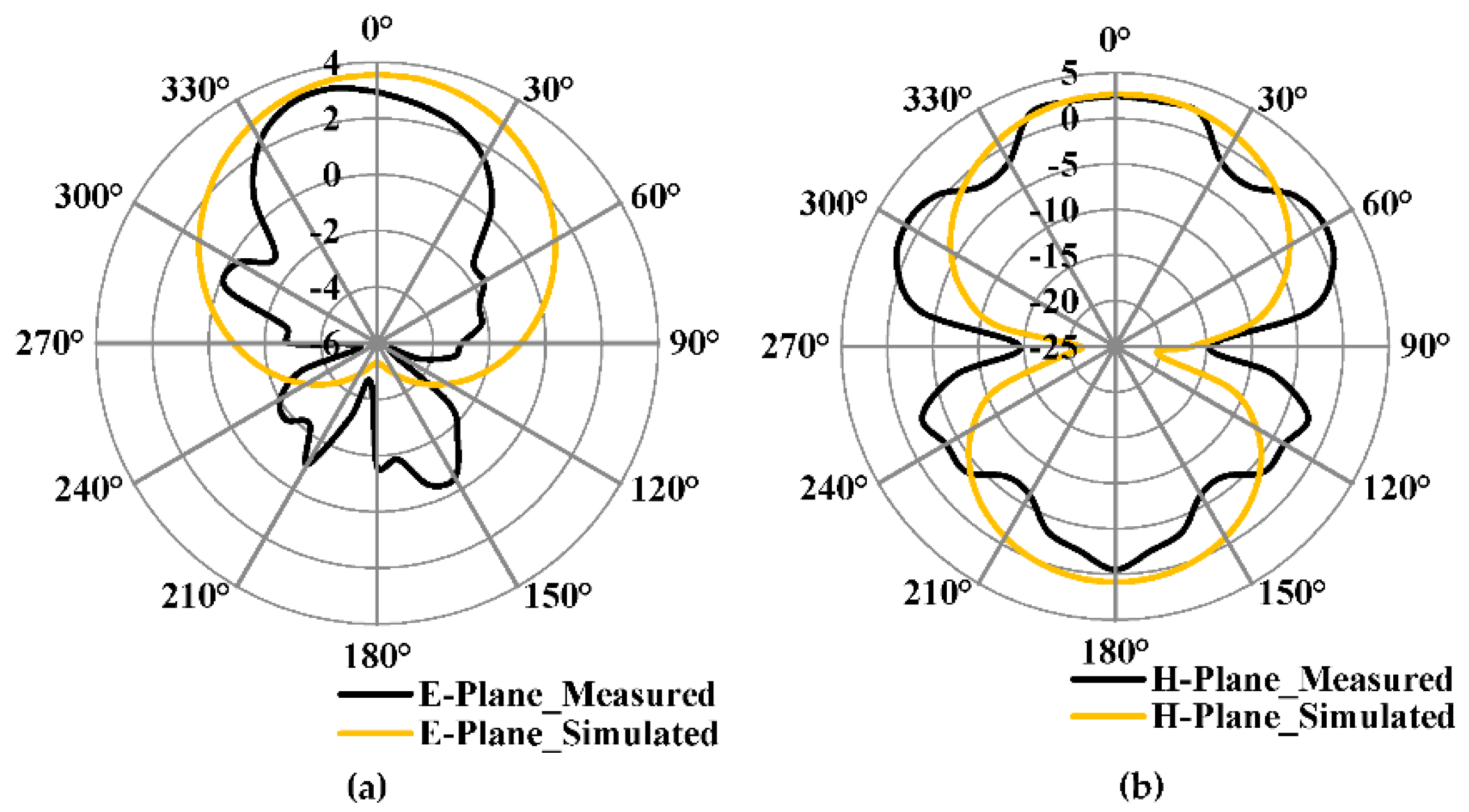

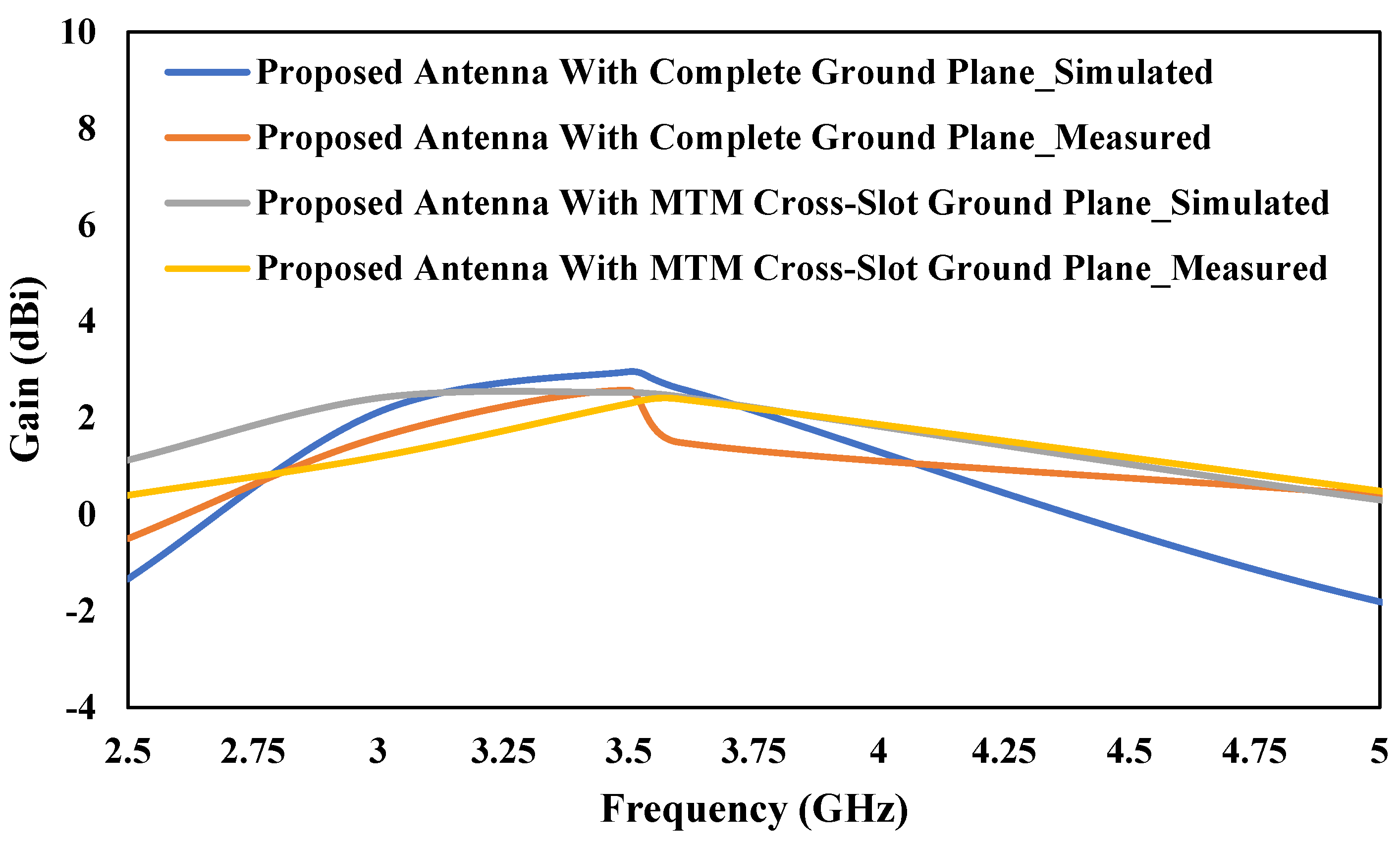
| CSRR Dimensions (Unit: mm) | |
|---|---|
| lc | 5 |
| wc | 4 |
| gc | 0.5 |
| tc | 0.5 |
| sc | 0.5 |
| Ref./Year | Structure | Operating Freq. (GHz) | Measured Bandwidth (%) | Gain (dBi) | Antenna Size | Substrate Thickness | Relative Permittivity |
|---|---|---|---|---|---|---|---|
| [52]/2020 | Two MTM SRR cells | 3.5 | 28.4 | 1.9 | 0.34λo × 0.26λo | 0.018λo | 4.4 |
| [53]/2017 | CRLH Cells | 3.5 | 14.1 | 1.6 | 0.40λo × 0.37λo | - | 4.4 |
| [54]/2021 | Triangular MTM patch antenna | 3.5 | 2.1 | 6.3 | 0.58λo × 0.58λo | 0.017λo | 3 |
| [55]/2021 | Mushroom MTM | 3.5 | 27.8 | 4.5 | 0.35λo × 0.35λo | 0.017λo | 2.2 |
| [56]/2016 | Complementary spiral resonators | 3.5 | 1.43 | 5.72 | 0.16λo × 0.08λo | 0.024λo | 2.65 |
| [57]/2021 | Polygonal SRR | 3.5 | 5.5 | 3 | 0.24λo × 0.35λo | 0.018λo | 4.4 |
| [58]/2019 | SRR-Loaded MTM | 3.5 | 9.7 | 2.25 | 0.35λo × 0.36λo | 0.018λo | 4.6 |
| This work/2022 | CSRR-MTM | 3.5 | 2.8 | 2.6 | 0.21λo × 0.39λo | 0.018λo | 4.3 |
| This work/2022 | CSRR-MTM with Cross-Slot MTM | 3.5 | 20 | 2.3 | 0.21λo × 0.39λo | 0.018λo | 4.3 |
Publisher’s Note: MDPI stays neutral with regard to jurisdictional claims in published maps and institutional affiliations. |
© 2022 by the authors. Licensee MDPI, Basel, Switzerland. This article is an open access article distributed under the terms and conditions of the Creative Commons Attribution (CC BY) license (https://creativecommons.org/licenses/by/4.0/).
Share and Cite
Karimbu Vallappil, A.; Khawaja, B.A.; Rahim, M.K.A.; Iqbal, M.N.; Chattha, H.T. Metamaterial-Inspired Electrically Compact Triangular Antennas Loaded with CSRR and 3 × 3 Cross-Slots for 5G Indoor Distributed Antenna Systems. Micromachines 2022, 13, 198. https://doi.org/10.3390/mi13020198
Karimbu Vallappil A, Khawaja BA, Rahim MKA, Iqbal MN, Chattha HT. Metamaterial-Inspired Electrically Compact Triangular Antennas Loaded with CSRR and 3 × 3 Cross-Slots for 5G Indoor Distributed Antenna Systems. Micromachines. 2022; 13(2):198. https://doi.org/10.3390/mi13020198
Chicago/Turabian StyleKarimbu Vallappil, Arshad, Bilal A. Khawaja, Mohamad Kamal A. Rahim, Muhammad Naeem Iqbal, and Hassan T. Chattha. 2022. "Metamaterial-Inspired Electrically Compact Triangular Antennas Loaded with CSRR and 3 × 3 Cross-Slots for 5G Indoor Distributed Antenna Systems" Micromachines 13, no. 2: 198. https://doi.org/10.3390/mi13020198







